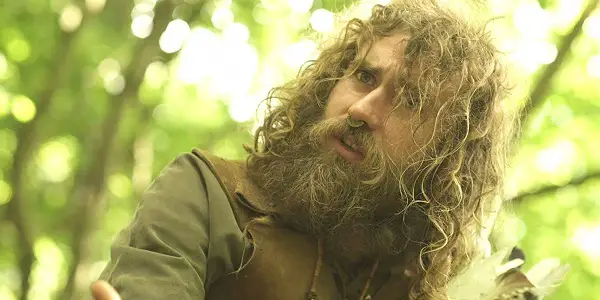The Bastard Sword is by no means an amazing film, but its incredibly low budget and relative quality make it an interesting film for those interested in the indie craft.
There’s a phrase used often among filmmakers: “just make it”. It’s easy to sit around pondering a new script or idea you have, but it’s a big step up – and a lot harder – to actually produce and film something. It’s impressive enough when a non-franchise studio blockbuster is created, but a tiny team creating their passion project is a truly commendable achievement.
That’s why The Bastard Sword is an interesting project – it’s certainly not the most technical or intellectually profound film but the tiny budget, and various routes director Eveshka Ghost took to mitigate this handicap, betray a real passion for the craft.
The Bastard Sword tells the story of an amnesiac (Xander Phillips) in a fantasy forest, who’s looking for a magical sword. Along the way he meets a strange hermit (Seth Easterbrook) and a clumsy bandit (Martyn Eade), who join him on his adventure. What seems like a standard adventure takes a few interesting twists and turns, with the characters’ secrets and deceptions eventually redefining the entire premise, however the film’s crippling run-time of three hours means it all takes far too long to get anywhere.
Old-School Fantasy
If the title didn’t make it abundantly clear, The Bastard Sword is a fantasy more in keeping with 70s/80s films and early RPGs than it is contemporary fantasy. It’s set entirely in a primordial forest, and concerns Medieval-style warriors and bandits coupled with light fantastical elements, with a focus on magical relics and the abstract states of “being” in the world. It’s rather cheesy, but that’s no insult for a film aiming this squarely at a genre.

Luckily for Ghost, the clearly established fairy tale and low fantasy aesthetic helps mitigate some of its most questionable flaws. The overly expositional dialogue and cheesy delivery, ill-defined world and stereotypical characters, and singular setting, all keep it in the vein of old-school fantasy B-movies or classic video game RPGs. Most of the dialogue in particular felt like it was written for video game NPCs, with lines delivered in an order that could be re-arranged with no detriment to the intention, and a proliferation of heavy exposition.
At the beginning of the film these elements feel awkward or uncomfortable, but once the film hits its stride they become part and parcel with the genre, and it’s a lot easier to appreciate them. However that speaks to a wider issue with the film – when it picks up momentum it becomes a rather intriguing tale, but thanks to a monumental run-time it has trouble reaching this pace.
Slowly Plodding Through The Woods
The Bastard Sword has a run-time of over three hours. Of course this is par for the course for the type of classic fantasy story Ghost is trying to tell, but the key difference is that this film was made on a coffee-paper-thin budget. According to the film’s Kickstarter page its budget was around £2,000 ($2,500), which means the film cost about £11 ($14) per minute (as a point of comparison, Avengers: Infinity War cost around £2 million ($2.5 million) per minute). The budget is stretched thin, and coupled with the film’s epic length it leaves the content feeling a little thin off the ground.
The real “plot” of the film only starts around 45 minutes in, and much of the penultimate half-hour or so feel totally unnecessary. Multiple scenes fulfill the same function or espouse previously established information or characteristics. In addition many shots seem to go on a few seconds too long or begin too early, and between the surplus footage, the film is likely an hour or so longer than it needs to be.
Still, the ball-and-chain of the budget only goes so far. There may be many corners cut in keeping the film-low budget, but Ghost shows a real knack for hiding these corners. There’s an omnipresent score, seemingly created using synthesized instruments on Logic or a similar program, which adds a nice level of subtext and production value. All of the locations are set in similar-looking woods, but scenes set at different times and shot in different ways work well to make the settings look sufficiently different. Some of the shots are actually pretty well framed (despite a persistent problem of too many close-ups and an overuse of mobile shots). All in all, it seems a lot of work went into increasing the production quality, and it shows.
The Bastard Sword: Conclusion
The Bastard Sword isn’t an amazing film: the unnecessary run-time exacerbates multiple smaller flaws, and the characters’ intriguing secrets and turns are hidden too far into the resulting mass to have much weight.
However it’s also one of the few films that seems fair to judge with regards to its context – £2,000 is an mindbogglingly low budget, and the resulting product is frankly impressive. The fact that it has the production quality it does is an impressive achievement, and the film should stand as a symbol to aspiring micro-budget filmmakers that anything is possible with the right motivation and drive.
What kind of film would you make if you only had a minuscule budget?
Does content like this matter to you?
Become a Member and support film journalism. Unlock access to all of Film Inquiry`s great articles. Join a community of like-minded readers who are passionate about cinema - get access to our private members Network, give back to independent filmmakers, and more.